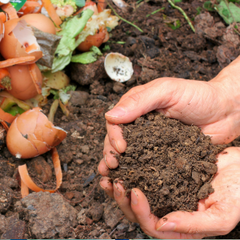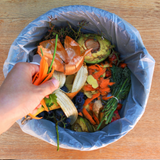CiboWares Blog
Blog Categories
View All Topics
Close
View All Topics
CloseBlog Categories


Community Composting on the Rise
In recent years many communities have shown interest in starting local composting programs. In some cases, the recession slowed their growth, but many of these attempts have thrived as communities began to work together to solve simple problems and effect change. Neighborhood composting is something that everyone in the community can participate in and the benefits of less pollution, reduced demand for landfill space and less trash being hauled away directly benefit everyone in the community.
The Benefits of Community Composting
-
Waste Reduction: Community composting is a powerful tool for waste reduction, diverting organic materials from landfills. By composting kitchen and yard waste together, communities cut down on landfill overflow and reduce harmful greenhouse gas emissions. This collective effort transforms what would be waste into valuable compost, contributing to a more sustainable and eco-friendly approach to waste management.

- Soil Enrichment: The compost produced is a nutrient-rich soil conditioner, enhancing the fertility and structure of local soils. As communities collectively compost kitchen scraps, garden waste, and more, they create a valuable resource that can be used to improve the quality of soil in community gardens, public spaces, and individual yards.
- Community Engagement: As residents join forces to compost together, they foster stronger bonds and a shared sense of responsibility. The act of composting becomes a communal effort, encouraging open communication and collaboration. Community composting initiatives often involve workshops or events, providing opportunities for neighbors to connect, share knowledge, and build a sense of pride in their collective efforts.
Community composting offers a range of benefits beyond just waste disposal. By collecting and composting organic materials together, neighborhoods actively reduce the amount of waste that ends up in landfills, contributing positively to the environment. The resulting compost becomes a natural and nutrient-rich soil enhancer, promoting healthier plants and gardens. In addition to these environmental advantages, community composting fosters a sense of shared responsibility and community bonding. As residents come together to compost, they build stronger connections and create awareness about sustainable practices. The compost generated becomes a valuable local resource that can be utilized to support local green initiatives. In essence, community composting is a practical and communal approach to waste management, delivering both environmental benefits and a more connected community.
Community Composting Success Stories
From Malibu to Minneapolis, there have been some very notable success stories of neighborhood composting. In Minnesota, one test involved the pick-up of compostable waste by a crew of people on bicycles hauling a small trailer carrying compost barrels. This was only one part of an experiment to see which collection method would work best, but it showed how creative people can be when they work together toward a common goal.

There are several community groups in New York City that provide compostable waste collection at local farmer’s markets. The waste is collected at the market and then sent off to a local composting company for processing. Then the compost is brought back to the market and sold to customers.
There are towns in The United Kingdom that have collection sites, hold regular seminars, publish a magazine, and hold clinics on how to start composting in your town. They even get the food growers involved to move the waste vegetable matter from their farms to the community compost heap.
How to Start Community Composting
Starting a community composting initiative involves a combination of education, infrastructure setup, and community engagement. If you and your neighborhood, community, village or hamlet want to get started composting, here are some basic guidelines to provide a structured approach to kick-starting and maintaining a successful composting project within a community.
- Community Assessment: look into the local community's interest in composting.
- Educational Outreach: Utilize social media and local channels to raise awareness and educate your community on the value of composting. Hold information sessions or workshops about the benefits of community composting to help increase interest.
- Identify Composting Sites: Find suitable locations for compost bins or piles and ensure the sites are accessible and comply with local regulations.
- Source Composting Bins and get set up: acquire bins and set up designated composting areas. Make sure you have clear guidelines available on what can be composted on signs for easy reference.
- Establish Collection System: Gather volunteers and set up a regular collection schedule for organic waste. Consider partnering with waste management services, or setting up designated times when community members can drop off organic waste.
- Monitor and Maintain: Monitor the composting sites to make sure they're functioning correctly and compost is being turned regularly for best results.
- Compost Distribution: Develop a plan to distribute the compost back to participants. Consider partnering with initiatives like community gardens.
- Evaluate and adjust: Get feedback from partners and community members on the initiative - be open to making adjustments based on community needs and preferences.
What types of waste can be community composted?

Here are some basic guidelines participants bringing in food items will need to follow. Acceptable items are: All fruit and vegetable peelings and pits, non-greasy food scraps or leftovers, rice, pasta, bread, cereal, coffee grounds with filter, tea bags, hair and nails (animal or human), egg and nut shells, cut or dried flowers, wreaths, and houseplants and potting soil. Unacceptable items are: meat, chicken and fish, greasy food scraps, fat and oil, dairy items: cheese, butter, dog or cat feces, kitty litter, coal or charcoal, coconuts, diseased and/or insect-infested houseplants and soil.
Educational Initiatives
Educational initiatives play a crucial role in informing communities about the significance of community composting and guiding them on how to participate effectively. Workshops and informational sessions can be organized to explain the environmental benefits of composting, emphasizing how it reduces waste in landfills and contributes to healthier soils. Visual aids, such as posters or brochures, can break down the composting process, illustrating what materials can and cannot be composted. Leveraging social media platforms, community websites, and local newsletters can help disseminate information widely, reaching a diverse audience. Additionally, interactive demonstrations or hands-on workshops provide a practical understanding of composting techniques, making the learning experience more engaging and accessible. By combining various educational approaches, communities can create a well-informed and enthusiastic base of participants for successful and sustainable community composting initiatives.
Collaborate with local businesses
Partnering with local businesses is a strategic and collaborative approach to initiate and sustain community composting initiatives. Begin by approaching local garden centers, hardware stores, or home improvement businesses to secure sponsorships or donations for composting bins and materials. Establishing partnerships with grocery stores or restaurants can provide a steady supply of organic waste for composting. Consider hosting joint events or workshops with these businesses to promote composting awareness and educate the community. Additionally, collaborate with local waste management services to streamline collection and processing. Engage in reciprocal relationships by promoting participating businesses through community events and initiatives, creating a mutually beneficial ecosystem that supports both the composting project and local enterprises. These partnerships not only enhance the success of community composting but also foster a sense of shared responsibility and sustainability within the local business community.
Compost Uprising: A Trend That's Here to Stay
The surge in community composting marks a promising shift towards more sustainable and environmentally conscious living. The growing movement is not just about reducing waste; it's a testament to communities coming together, realizing the collective impact they can make on the environment. From small neighborhoods to entire towns, the rise of community composting reflects a shared commitment to responsible waste management, soil enrichment, and fostering stronger community bonds. As more people join this green revolution, the benefits extend beyond individual gardens or local parks; they contribute to a broader, positive transformation in the way we perceive and handle our waste. Community composting is not merely a trend; it's a powerful symbol of collective responsibility and a promising step towards a greener, more sustainable future for us all.
Looking for compostable products?
Shop these categories:
